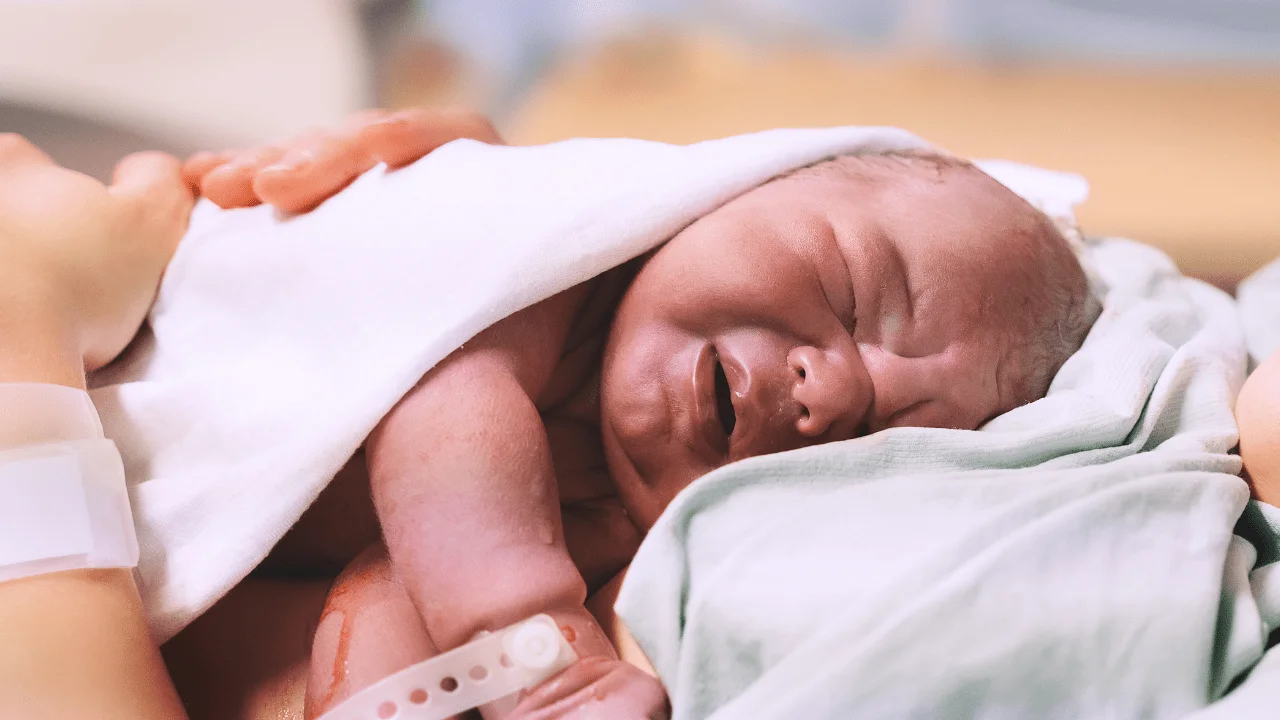
ቬርኒክስ ካሴሶሳ ማለት “ቺስ ቫርኒሽ” ማለት ነው - በሦስተኛው ወር ሶስት ወራት ውስጥ እና ወዲያው ከተወለዱ በኋላ በህፃናት ቆዳ ላይ ስላለው የሰም ሽፋን በጣም ትክክለኛ መግለጫ። የውሃ፣ የሞቱ የቆዳ ህዋሶች እና የሰባ ንጥረ ነገሮች ጥምረት፣ ቬርኒክስ ካሴሶሳ ለህፃናት ብዙ ጥቅሞች አሉት እነዚህም ቆዳቸው እርጥበት እንዲይዝ ማድረግ፣ በወሊድ ቦይ በኩል ያለውን መተላለፊያ መቀባት፣ ጎጂ ባክቴሪያዎችን መከላከል እና የምግብ መፈጨት ትራክት እንዲያድግ መርዳት ይገኙበታል። ቨርኒክስ የጤና አጠባበቅ ባለሙያዎች ልጅዎን ከመታጠብዎ በፊት ከወለዱ በኋላ ቢያንስ ለ 24 ሰዓታት እንዲጠብቁ ከሚመከሩበት አንዱ ምክንያት ነው።
በዚህ ጽሑፍ ውስጥ
- ቬርኒክስ ካሴሶሳ ምንድን ነው?
- ቬርኒክስ ካሴሶሳ ምን ያደርጋል?
- የ ቬርኒክስ ካሴሶሳ ጥቅሞች ምንድ ናቸው?
- የልጄን የመጀመሪያ መታጠቢያ ማዘግየት አለብኝ?
- ቫርኒክስ በልጄ ላይ ለምን ያህል ጊዜ እንዲቆይ መፍቀድ አለብኝ?
- ስለ ቬርኒክስ ካሴሶሳ መጨነቅ አለብኝ?
ቬርኒክስ ካሴሶሳ ምንድን ነው?
ቬርኒክስ ካሴሶሳ በሦስተኛው ወር ሶስት ወር እና ከወሊድ በኋላ የሕፃኑን ታዳጊ ቆዳ የሚለብስ እና የሚከላከል የሰም ንጥረ ነገር ነው። ከውሃ, ከሞቱ የቆዳ ሴሎች እና ስብ (የሴባሴስ ፈሳሾች) የተሰራ ነው. ስሙ ከላቲን የመጣ ነው፡ ቬርኒክስ ማለት “ቫርኒሽ” ማለት ሲሆን ካሴሶሳ ማለት ደግሞ “ቺዝ” ማለት ነው። ቨርኒክስ ካሴሶሳ በሦስተኛው ወር እና ከወሊድ በኋላ የህፃኑን ቆዳ የሚለብስ እና የሚከላከል የሰም ንጥረ ነገር ነው። ከውሃ, ከሞቱ የቆዳ ሴሎች እና ስብ (የሴባሴስ ፈሳሾች) የተሰራ ነው. ስሙ ከላቲን የመጣ ነው፡ ቬርኒክስ ማለት “ቫርኒሽ” ማለት ሲሆን ካሴሶሳ ደግሞ “ቺሲ” ማለት ነው።
ሕፃናት፣ በተለይም የመድረሻ ቀናቸው ከመድረሱ በፊት የሚመጡት፣ በቆዳቸው ላይ የተወሰነ መጠን ያለው ቫርኒክስ ይዘው ይወለዳሉ። ይህ ሽፋን ቆዳውን ሊሸፍን ይችላል, ወይም በአንገቱ ግርዶሽ እና በጣቶች እና በጣቶቹ መካከል ብቻ ሊገኝ ይችላል.
ቬርኒክስ ካሴሶሳ ምን ያደርጋል?
በማህፀን ውስጥ ያሉ ሕፃናት በጣም ስስ፣ ያልበሰሉ ቆዳዎች ለድርቀት እና ብስጭት የተጋለጡ ናቸው። ቬርኒክስ ለህጻናት ስሜታዊ ቆዳ እንደ መከላከያ ሆኖ ያገለግላል, ተፈጥሯዊ እርጥበትን ይቆልፋል እና ባክቴሪያዎችን ይከላከላል.
የ ቬርኒክስ ካሴሶሳ ጥቅሞች ምንድ ናቸው?
የሕፃኑን ቆዳ በማህፀን ውስጥ የሚከላከል እንቅፋት እና ከተወለደ በኋላ ወዲያውኑ ቨርኒክስ ካሴሶሳ ብዙ ጥቅሞች አሉት።
የአካል ክፍሎች እንዲፈጠሩ ይረዳል
የቬርኒክስ ህዋሶች ጠፍተዋል እና ከ ጋር ይደባለቃሉ አምኒኦቲክ ፈሳሽ ያ ሕፃን ይውጣል እና በማህፀን ውስጥ "መተንፈስ" ይለማመዳል. እነዚህ ሴሎች በጨጓራና ትራክት ውስጥ የሴሎች እድገትን የሚያበረታቱ አሚኖ አሲዶች እና ሌሎች ንጥረ ነገሮችን ይይዛሉ. ንጥረ ነገሩ የሳንባዎችን ተግባር ለማገዝ ከሰርፋክተሮች ጋር ይጣመራል።
ቆዳን እርጥበት ይይዛል
በአብዛኛው ከውሃ እና ከቅባት ንጥረ ነገሮች የተሰራው ቬርኒክስ የሕፃኑን ቆዳ በማህፀን ውስጥ ይለብሳል ይህም በማደግ ላይ እና ከተወለደ በኋላ ወዲያውኑ እርጥበት እና እርጥበት እንዲኖረው ይረዳል.
የሙቀት መጠንን ይቆጣጠራል
የውሃ ትነት ከቆዳው እንዲቀዘቅዝ ይረዳል (ለምን ነው ላብ ያለብዎት!). ቫርኒክስ የውሃ ብክነትን ለመከላከል ስለሚረዳ, ለማቆየት ይረዳል አዲስ የተወለዱ ሕፃናት ሞቃታማ - በተለይም ከመወለዳቸው በፊት የተወለዱ፣ በቆዳው ውስጥ ውሃን በፍጥነት የማጣት ዝንባሌ ያላቸው።
መላክን ያቃልላል
በወሊድ ጊዜ ቨርኒክስ ህፃኑ በወሊድ ቦይ ውስጥ ሲያልፍ ግጭት ይቀንሳል።
ከጎጂ ማይክሮቦች ይከላከላል
ጥናቶች እንደሚያሳዩት ቬርኒክስ ጎጂ ሊሆኑ ከሚችሉ ማይክሮቦች ለመከላከል እንዲረዳው የራሱን ማይክሮባዮም ወይም ተስማሚ ባክቴሪያዎችን እና ሌሎች ረቂቅ ህዋሳትን የሚያበረታታ አንቲባዮቲክ ባህሪያት አሉት.
ቆዳን ለማዳን ይረዳል
የቬርኒክስ ልዩ ቅንብር የሕፃናት ቆዳ እንዲፈወስ ይረዳል. እንደ እውነቱ ከሆነ ተመራማሪዎች የሕፃናት እና የአዋቂዎች ቆዳ ከቃጠሎ እና ከጉዳት ለመፈወስ የሚረዳ ቬርኒክስ የመሰለ ክሬም ማዘጋጀት ይቻል እንደሆነ እየመረመሩ ነው.
የልጄን የመጀመሪያ መታጠቢያ ማዘግየት አለብኝ?
ሆስፒታሎች ከተወለዱ በኋላ ወዲያውኑ ሕፃናትን ይታጠቡ ነበር፣ ነገር ግን በእነዚህ ቀናት ብዙ ሐኪሞች ያንን የመጀመሪያ መጥመቅ እያዘገዩ ነው። የዓለም ጤና ድርጅት አዲስ የተወለደውን ልጅ ከመታጠብዎ በፊት ቢያንስ 24 ሰዓታትን መጠበቅ ወይም በባህላዊ ምክንያቶች ሙሉ ቀን የማይቻል ከሆነ ስድስት ሰዓት መጠበቅን ይመክራል.
የሕፃኑን የመጀመሪያ መታጠቢያ ማዘግየት የሕፃኑን ቆዳ ማይክሮባዮም ይደግፋል እና ከኢንፌክሽን ይከላከላል ሲል የሴቶች የጽንስና ጤና እና አራስ ነርሶች ማህበር አስታውቋል። በተጨማሪም ዝቅተኛ የደም ስኳር መጠን እንዲቀንስ፣ የክብደት መቀነስ እና የጃንዲስ በሽታን እንዲሁም አዲስ የተወለደ ሕፃን የሰውነት ሙቀት እንዲረጋጋ ይረዳል።
ቫርኒክስ በልጄ ላይ ለምን ያህል ጊዜ እንዲቆይ መፍቀድ አለብኝ?
ቨርኒክስ ካሴሶሳ ከተወለደ ከ24 እስከ 48 ሰአታት ውስጥ ብቻውን ወደ ቆዳ ውስጥ ይገባል፣ይህም አንዱ ምክኒያት የህፃናት ህክምና ህጻን ልጅዎን ከመታጠብዎ በፊት ሙሉ ቀን እንዲጠብቁ ይመክራል።
ስለ ቬርኒክስ ካሴሶሳ መጨነቅ አለብኝ?
ቨርኒክስ ካሴሶሳ ከተወለደ በኋላ በልጅዎ ቆዳ ላይ ስለሚቆይ የሚያሳስብ ምንም ምክንያት የለም። ይሁን እንጂ የጤና እንክብካቤ አቅራቢዎች እናት አዎንታዊ ከሆነች ከተወለዱ በኋላ ወዲያውኑ ሕፃናትን ይታጠባሉ ኤችአይቪ ወይም ሄፓታይተስ ሲ, የቫይረስ ስርጭት አደጋን ለመቀነስ. ልጅዎ የ chorioamnionitis ወይም meconium እድፍ ካለበት የባክቴሪያ ኢንፌክሽን ስጋትን ለመቀነስ ገላ መታጠብ ሊመከር ይችላል።
ተጨማሪ ያንብቡ


አስተያየት ጨምር